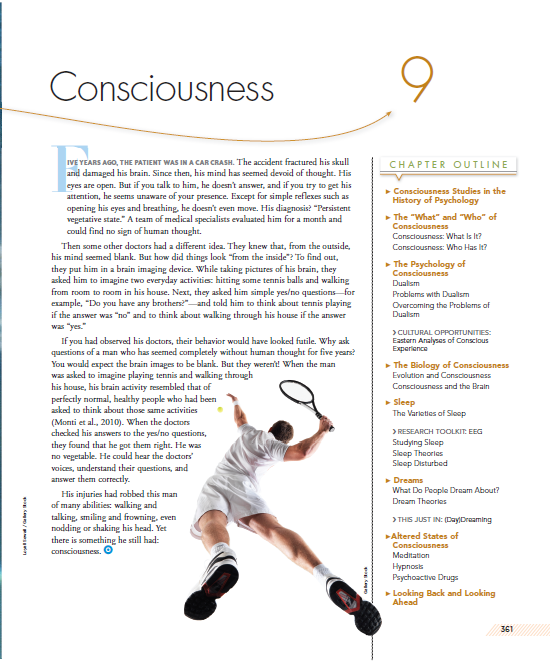Chapter 9. Consciousness
9.1 Introduction


9.2 Slide 2
Since the very beginnings of scientific psychology, researchers have been interested in the flow of conscious thoughts – the ideas that come to mind in each person’s ongoing “stream of consciousness.” This Try This! activity concerns this flow of conscious thoughts.
To do this activity, you need to be in a quiet place with no distractions. Don’t do the task in a room with friends, while watching TV, sending text messages, etc. Instead, find a place where you won’t be interrupted for 5-10 minutes. Once you are in that quiet, uninterrupted place, go on to the next page.
9.3 Slide 3
In the first step of this exercise, you should to pay close attention to your own naturally-occurring flow of thoughts. Specifically, once you get to the next screen, you will let your thoughts flow freely for a period of two minutes.
During these two minutes, your task is to signal every time the content of your thought changes from one idea to another. For example, suppose you begin by thinking about the experimental instructions, and then
— thoughts about an upcoming class come to mind, and then
— you realize you’re getting hungry, and then
— you think about the experimental instructions again.
You would click or tap a signal bar three times, that is, each time your thinking changed from one idea to another.
On the next page, you will be prompted to begin the task; the screen will tell you to start and then tell you to stop two minutes later. So when you are ready to start the task of recording changes in your thoughts, please go on the to next screen.
9.4 Slide 4
In a moment, a green START sign will appear on screen. When you are ready, click or tap it and let your thoughts flow freely. Pay close attention to what you are thinking, and click or tap the button in the middle of your screen every time the content of your thought changes from one idea to another.
When you are ready, click or tap the green START button and let your thoughts flow freely…
START
STOP
End of Step 1
9.5 Slide 5
In Step 2 of this Try This! exercise, you again will let your thoughts flow freely for two minutes. This time there is no requirement to note each change in thought. Instead, your task is to try not to think of a white bear. Every time you do think of the words “white bear” or an image of a white bear comes to mind, please click or tap the signal button on the screen. Again, try not to think of a white bear. But whenever a white bear thought comes to mind, click or tap the signal button. Press “start task “when ready to begin.
9.6 Slide 6
In a few moments, a green START sign will appear on screen. When you are ready, click or tap it and let your thoughts flow freely. Pay close attention to what you are thinking, and click or tap the button in the middle of your screen according to the instructions you were given on the previous screen (whenever a certain thought comes to mind).
START
STOP
End of Step 2
9.7 Slide 7
Finished! Here are your results and an explanation. The main part of this activity was the second two-minute period, involving the “white bear” task. (The first two-minute period was a warm-up designed to familiarize you with the general instructions and procedure.)
During the white bear part of the activity, you indicated that you thought of a white bear [___] times during the first 60 seconds of the two-minute period, and [____] times during the second 60 seconds.
In the original research using this task, which was devised by psychologist Dan Wegner and colleagues (1987), participants on average thought of a white bear about 3.5 times during the first minute (i.e., the first 60 seconds) and about 2 times during the second minute. Here are your results and those from the study:
9.8 Slide 9
In retrospect, this result is surprising. People were instructed not to think of a white bear at all. Nonetheless, white bear thoughts popped into mind a few times a minute!
This result has an important implication: The contents of your conscious mind are not entirely under your control. Even if you’re trying not to think of something, that thing may enter your conscious experience.
You’ll learn more about this uncontrollable nature of conscious experience, and also techniques to gain greater control over your conscious mind, when you return to the chapter. So please do that now.
This activity was inspired by and based on:
Wegner, D. M., Schneider, D. J., Carter, S. R., & White, T. L. (1987). Paradoxical effects of thought suppression. Journal of Personality and Social Psychology, 53, 5-13.